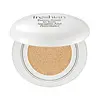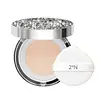What's inside
What's inside
 Key Ingredients
Key Ingredients

 Benefits
Benefits

 Concerns
Concerns

 Ingredients Side-by-side
Ingredients Side-by-side

Water
Skin ConditioningCyclopentasiloxane
EmollientMethyl Trimethicone
Skin ConditioningButylene Glycol
HumectantEthylhexyl Methoxycinnamate
UV AbsorberPEG-10 Dimethicone
Skin ConditioningTrimethylsiloxysilicate
EmollientPolymethyl Methacrylate
Titanium Dioxide
Cosmetic ColorantNiacinamide
Smoothing1,2-Hexanediol
Skin ConditioningMagnesium Sulfate
Cetyl PEG/PPG-10/1 Dimethicone
EmulsifyingAlumina
AbrasiveBoron Nitride
AbsorbentSynthetic Fluorphlogopite
Disteardimonium Hectorite
StabilisingPanthenol
Skin ConditioningZinc Stearate
Cosmetic ColorantAluminum Hydroxide
EmollientStearic Acid
CleansingDistearyldimonium Chloride
Palmitoyl Proline
Skin ConditioningTriethoxycaprylylsilane
Adenosine
Skin ConditioningMagnesium Palmitoyl Glutamate
Skin ConditioningSodium Palmitoyl Sarcosinate
CleansingBiosaccharide Gum-1
HumectantAluminum Myristate
Emulsion StabilisingPalmitic Acid
EmollientEthylhexylglycerin
Skin ConditioningCeramide NP
Skin ConditioningHyaluronic Acid
HumectantHydrolyzed Hyaluronic Acid
HumectantHydrolyzed Sodium Hyaluronate
Skin ConditioningHydroxypropyltrimonium Hyaluronate
Madecassoside
AntioxidantSodium Hyaluronate
HumectantPentaerythrityl Tetra-Di-T-Butyl Hydroxyhydrocinnamate
AntioxidantCodonopsis Lanceolata Root Extract
Skin ConditioningFicus Carica Fruit Extract
HumectantMelissa Officinalis Leaf Extract
Skin ConditioningPunica Granatum Fruit Extract
AntioxidantParfum
MaskingLimonene
PerfumingLinalool
PerfumingHexyl Cinnamal
PerfumingCI 77891
Cosmetic ColorantChromium Hydroxide Green
Ferric Chloride
AstringentCuprous Oxide
Skin ConditioningWater, Cyclopentasiloxane, Methyl Trimethicone, Butylene Glycol, Ethylhexyl Methoxycinnamate, PEG-10 Dimethicone, Trimethylsiloxysilicate, Polymethyl Methacrylate, Titanium Dioxide, Niacinamide, 1,2-Hexanediol, Magnesium Sulfate, Cetyl PEG/PPG-10/1 Dimethicone, Alumina, Boron Nitride, Synthetic Fluorphlogopite, Disteardimonium Hectorite, Panthenol, Zinc Stearate, Aluminum Hydroxide, Stearic Acid, Distearyldimonium Chloride, Palmitoyl Proline, Triethoxycaprylylsilane, Adenosine, Magnesium Palmitoyl Glutamate, Sodium Palmitoyl Sarcosinate, Biosaccharide Gum-1, Aluminum Myristate, Palmitic Acid, Ethylhexylglycerin, Ceramide NP, Hyaluronic Acid, Hydrolyzed Hyaluronic Acid, Hydrolyzed Sodium Hyaluronate, Hydroxypropyltrimonium Hyaluronate, Madecassoside, Sodium Hyaluronate, Pentaerythrityl Tetra-Di-T-Butyl Hydroxyhydrocinnamate, Codonopsis Lanceolata Root Extract, Ficus Carica Fruit Extract, Melissa Officinalis Leaf Extract, Punica Granatum Fruit Extract, Parfum, Limonene, Linalool, Hexyl Cinnamal, CI 77891, Chromium Hydroxide Green, Ferric Chloride, Cuprous Oxide
Water
Skin ConditioningCI 77891
Cosmetic ColorantPhenyl Trimethicone
Skin ConditioningIsononyl Isononanoate
EmollientButylene Glycol
HumectantCyclopentasiloxane
EmollientGlycerin
HumectantPentaerythrityl Tetraethylhexanoate
EmollientCetyl PEG/PPG-10/1 Dimethicone
EmulsifyingCaprylic/Capric Triglyceride
MaskingMica
Cosmetic ColorantCyclohexasiloxane
Emollient1,2-Hexanediol
Skin ConditioningDisteardimonium Hectorite
StabilisingIsododecane
EmollientBis-PEG/PPG-14/14 Dimethicone
EmollientAcrylates/Polytrimethylsiloxymethacrylate Copolymer
Skin ConditioningMagnesium Sulfate
Stearoyl Inulin
EmollientCI 77492
Cosmetic ColorantGlyceryl Tribehenate/Isostearate/Eicosandioate
EmollientChlorella Vulgaris Extract
Skin ConditioningGlucose
HumectantPolyglyceryl-2 Diisostearate
EmulsifyingGlyceryl Caprylate
EmollientAluminum Hydroxide
EmollientFructooligosaccharides
HumectantFructose
HumectantCI 77491
Cosmetic ColorantTriethoxycaprylylsilane
Dimethicone
EmollientCetearyl Dimethicone/Vinyl Dimethicone Crosspolymer
EmollientEthylhexylglycerin
Skin ConditioningCentella Asiatica Extract
CleansingChamomilla Recutita Flower Extract
MaskingAluminum Dimyristate
Emulsion StabilisingCI 77499
Cosmetic ColorantParfum
MaskingTrisodium Ethylenediamine Disuccinate
Ceramide NP
Skin ConditioningPanthenol
Skin ConditioningPentaerythrityl Tetra-Di-T-Butyl Hydroxyhydrocinnamate
AntioxidantCentella Asiatica Leaf Extract
Skin ConditioningWater, CI 77891, Phenyl Trimethicone, Isononyl Isononanoate, Butylene Glycol, Cyclopentasiloxane, Glycerin, Pentaerythrityl Tetraethylhexanoate, Cetyl PEG/PPG-10/1 Dimethicone, Caprylic/Capric Triglyceride, Mica, Cyclohexasiloxane, 1,2-Hexanediol, Disteardimonium Hectorite, Isododecane, Bis-PEG/PPG-14/14 Dimethicone, Acrylates/Polytrimethylsiloxymethacrylate Copolymer, Magnesium Sulfate, Stearoyl Inulin, CI 77492, Glyceryl Tribehenate/Isostearate/Eicosandioate, Chlorella Vulgaris Extract, Glucose, Polyglyceryl-2 Diisostearate, Glyceryl Caprylate, Aluminum Hydroxide, Fructooligosaccharides, Fructose, CI 77491, Triethoxycaprylylsilane, Dimethicone, Cetearyl Dimethicone/Vinyl Dimethicone Crosspolymer, Ethylhexylglycerin, Centella Asiatica Extract, Chamomilla Recutita Flower Extract, Aluminum Dimyristate, CI 77499, Parfum, Trisodium Ethylenediamine Disuccinate, Ceramide NP, Panthenol, Pentaerythrityl Tetra-Di-T-Butyl Hydroxyhydrocinnamate, Centella Asiatica Leaf Extract
 Reviews
Reviews

Ingredients Explained
These ingredients are found in both products.
Ingredients higher up in an ingredient list are typically present in a larger amount.
1,2-Hexanediol is a synthetic liquid and another multi-functional powerhouse.
It is a:
- Humectant, drawing moisture into the skin
- Emollient, helping to soften skin
- Solvent, dispersing and stabilizing formulas
- Preservative booster, enhancing the antimicrobial activity of other preservatives
Aluminum Hydroxide is a form of aluminum. It can be naturally found in nature as the mineral gibbsite. In cosmetics, Aluminum Hydroxide is used as a colorant, pH adjuster, and absorbent.
As a colorant, Aluminum Hydroxide may add opacity, or reduce the transparency. Aluminum hydroxide is contains both basic and acidic properties.
According to manufacturers, this ingredient is an emollient and humectant. This means it helps hydrate the skin.
In medicine, this ingredient is used to help relieve heartburn and help heal ulcers.
There is currently no credible scientific evidence linking aluminum hydroxide in cosmetics to increased cancer risk.
Major health organizations allow the use of aluminum hydroxide in personal care products and have not flagged it as a carcinogenic risk at typical usage levels.
Learn more about Aluminum HydroxideButylene Glycol (or BG) is used within cosmetic products for a few different reasons:
Overall, Butylene Glycol is a safe and well-rounded ingredient that works well with other ingredients.
Though this ingredient works well with most skin types, some people with sensitive skin may experience a reaction such as allergic rashes, closed comedones, or itchiness.
Learn more about Butylene GlycolCeramide NP is a type of ceramide and formally known as ceramide 3.
Ceramides are intercellular lipids naturally found in our skin that bonds dead skin cells together to create a barrier. They are known for their ability to hold water and thus are a great ingredient for dry skin.
Ceramides are an important building block for our skin barrier. A stronger barrier helps the skin look more firm and hydrated. By bolstering the skin ceramides act as a barrier against irritating ingredients. This can help with inflammation as well.
If you would like to eat ceramides, sweet potatoes contain a small amount.
Read more about other common types of ceramides here:
Ceramide AP
Ceramide EOP
This ingredient is a high molecular weight silicone. It has emulsifying and skin conditioning properties.
Ci 77891 is a white pigment from Titanium dioxide. It is naturally found in minerals such as rutile and ilmenite.
It's main function is to add a white color to cosmetics. It can also be mixed with other colors to create different shades.
Ci 77891 is commonly found in sunscreens due to its ability to block UV rays.
Learn more about CI 77891Cyclopentasiloxane, or D5, is a silicone used to improve texture of products and trap moisture.
D5 is considered lightweight and volatile. Volatile means it evaporates quickly after application. Once evaporated, D5 leaves a thin barrier that helps keep skin hydrated.
It is also an emollient. Emollients help soften the skin and prevent water loss. Silicones create a silky texture in products. D5 helps other ingredients become more spreadable.
Studies show D5 is safe to use in skincare products. We recommend speaking with a skincare professional if you have concerns.
Learn more about CyclopentasiloxaneDisteardimonium Hectorite comes from the clay mineral named hectorite. It is used to add thickness to a product.
It can also help stabilize a product by helping to disperse other ingredients.
Hectorite is a rare, white clay mineral.
Learn more about Disteardimonium HectoriteEthylhexylglycerin (we can't pronounce this either) is commonly used as a preservative and skin softener. It is derived from glyceryl.
You might see Ethylhexylglycerin often paired with other preservatives such as phenoxyethanol. Ethylhexylglycerin has been found to increase the effectiveness of these other preservatives.
Magnesium Sulfate is a salt. More specifically, it is an epsom salt, or the bath salt used to help relieve muscle aches.
Despite having ‘sulfate’ in the name, it isn’t a surfactant or cleansing agent like sodium lauryl sulfate. Unlike those sulfates, magnesium sulfate doesn’t have the same cleansing or foaming properties (it's simply a type of salt).
In cosmetics, Magnesium Sulfate is used to thicken a product or help dilute other solids. It is a non-reactive and non-irritating ingredient.
One study shows magnesium deficiency may lead to inflammation of the skin. Applying magnesium topically may help reduce inflammation.
You can find this ingredient in sea water or mineral deposits.
Learn more about Magnesium SulfatePanthenol is a common ingredient that helps hydrate and soothe the skin. It is found naturally in our skin and hair.
There are two forms of panthenol: D and L.
D-panthenol is also known as dexpanthenol. Most cosmetics use dexpanthenol or a mixture of D and L-panthenol.
Panthenol is famous due to its ability to go deeper into the skin's layers. Using this ingredient has numerous pros (and no cons):
Like hyaluronic acid, panthenol is a humectant. Humectants are able to bind and hold large amounts of water to keep skin hydrated.
This ingredient works well for wound healing. It works by increasing tissue in the wound and helps close open wounds.
Once oxidized, panthenol converts to pantothenic acid. Panthothenic acid is found in all living cells.
This ingredient is also referred to as pro-vitamin B5.
Learn more about PanthenolParfum is a catch-all term for an ingredient or more that is used to give a scent to products.
Also called "fragrance", this ingredient can be a blend of hundreds of chemicals or plant oils. This means every product with "fragrance" or "parfum" in the ingredients list is a different mixture.
For instance, Habanolide is a proprietary trade name for a specific aroma chemical. When used as a fragrance ingredient in cosmetics, most aroma chemicals fall under the broad labeling category of “FRAGRANCE” or “PARFUM” according to EU and US regulations.
The term 'parfum' or 'fragrance' is not regulated in many countries. In many cases, it is up to the brand to define this term.
For instance, many brands choose to label themselves as "fragrance-free" because they are not using synthetic fragrances. However, their products may still contain ingredients such as essential oils that are considered a fragrance by INCI standards.
One example is Calendula flower extract. Calendula is an essential oil that still imparts a scent or 'fragrance'.
Depending on the blend, the ingredients in the mixture can cause allergies and sensitivities on the skin. Some ingredients that are known EU allergens include linalool and citronellol.
Parfum can also be used to mask or cover an unpleasant scent.
The bottom line is: not all fragrances/parfum/ingredients are created equally. If you are worried about fragrances, we recommend taking a closer look at an ingredient. And of course, we always recommend speaking with a professional.
Learn more about ParfumPentaerythrityl Tetra-Di-T-Butyl Hydroxyhydrocinnamate (long name, huh?) is a synthetic antioxidant.
It is used to help stabilize other antioxidants or prevent the color from changing in a product.
As an antioxidant, it helps fight free-radical molecules. Free-radical molecules are capable of damaging our cells and other genetic material. Thus, antioxidants may reduce the signs of aging.
This ingredient is oil-soluble.
Learn more about Pentaerythrityl Tetra-Di-T-Butyl HydroxyhydrocinnamateTriethoxycaprylylsilane is a silicone used to bind and stabilize ingredients.
As an emulsifier, it helps prevent ingredients from separating. This can help elongate the shelf life of products.
Triethoxycaprylylsilane is often used to coat mineral sunscreens ingredients to help give a better feel. It also helps reduce oxidative stress in sunscreens.
Learn more about TriethoxycaprylylsilaneWater. It's the most common cosmetic ingredient of all. You'll usually see it at the top of ingredient lists, meaning that it makes up the largest part of the product.
So why is it so popular? Water most often acts as a solvent - this means that it helps dissolve other ingredients into the formulation.
You'll also recognize water as that liquid we all need to stay alive. If you see this, drink a glass of water. Stay hydrated!
Learn more about Water